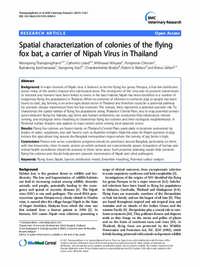Spatial characterization of colonies of the flying fox bat, a carrier of Nipah Virus in Thailand

Authors:
A major reservoir of Nipah virus is believed to be the flying fox genus Pteropus, a fruit bat distributed
across many of the world’s tropical and sub-tropical areas. The emergence of the virus and its zoonotic transmission
to livestock and humans have been linked to losses in the bat’s habitat. Nipah has been identified in a number of
indigenous flying fox populations in Thailand. While no evidence of infection in domestic pigs or people has been
found to date, pig farming is an active agricultural sector in Thailand and therefore could be a potential pathway
for zoonotic disease transmission from the bat reservoirs. The disease, then, represents a potential zoonotic risk. To
characterize the spatial habitat of flying fox populations along Thailand’s Central Plain, and to map potential contact
zones between flying fox habitats, pig farms and human settlements, we conducted field observation, remote
sensing, and ecological niche modeling to characterize flying fox colonies and their ecological neighborhoods. A
Potential Surface Analysis was applied to map contact zones among local epizootic actors.
